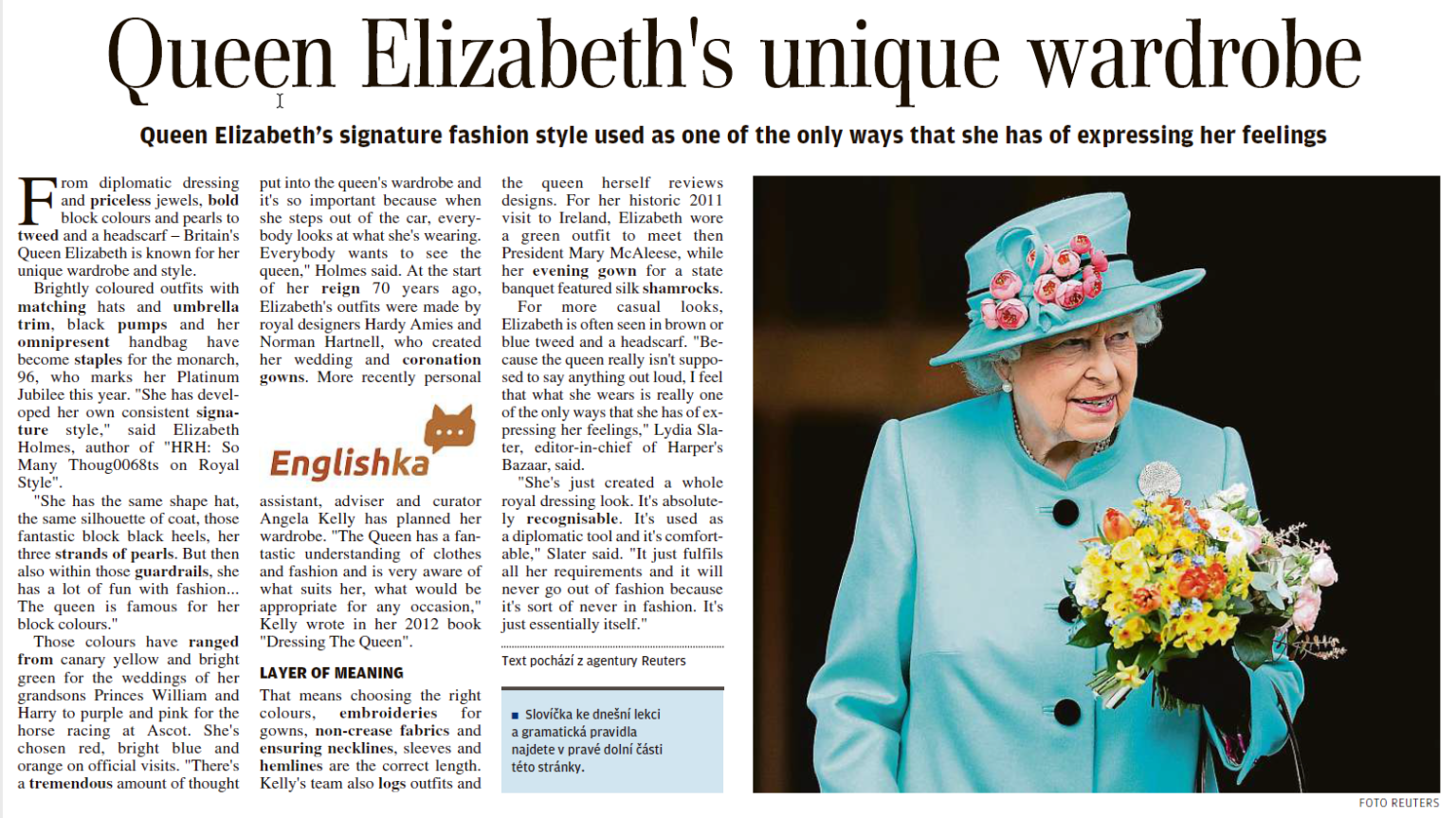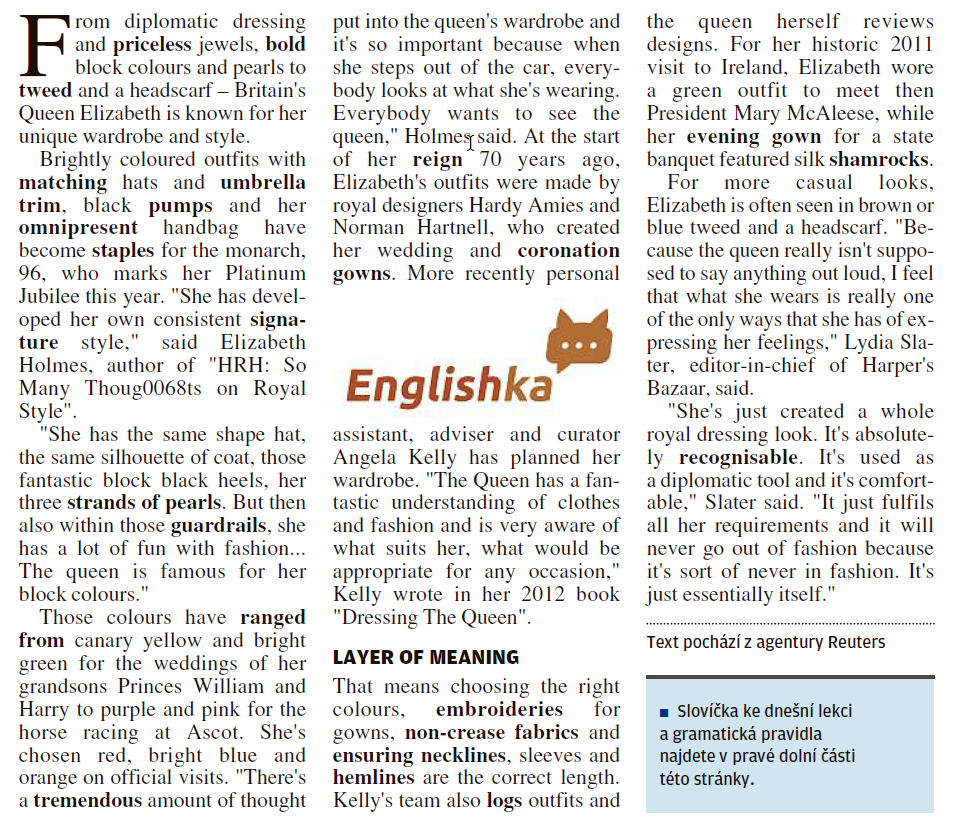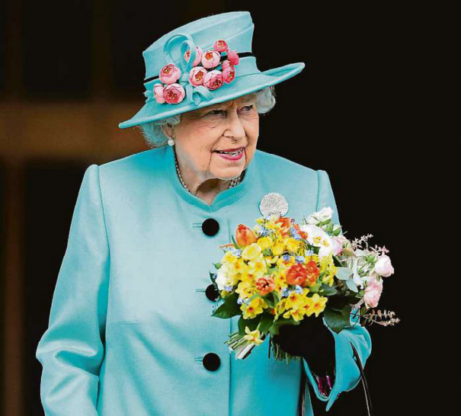Angličtina pro pokročilé s novinovými články (2.) – šatník královny Alžběty

Přečtěte si článek a projděte si slovní zásobu, gramatiku a cvičení, které najdete v přiloženém souboru dole. Celý text si také můžete stáhnout společně s nahrávkami od rodilého mluvčího.
Procvičování je vhodné pro úroveň B1 a vyšší.
1. Novinový článek
Queen Elizabeth’s unique wardrobe
Queen Elizabeth’s signature fashion style used as one of the only ways that she has of expressing her feelings

From diplomatic dressing and priceless jewels, bold block colours and pearls to tweed and a headscarf – Britain’s Queen Elizabeth is known for her unique wardrobe and style.
Brightly coloured outfits with matching hats and umbrella trim, black pumps and her omnipresent handbag have become staples for the monarch, 96, who marks her Platinum Jubilee this year. „She has developed her own consistent signature style,“ said Elizabeth Holmes, author of „HRH: So Many Thoughts on Royal Style“.
„She has the same shape hat, the same silhouette of coat, those fantastic block black heels, her three strands of pearls. But then also within those guardrails, she has a lot of fun with fashion… The queen is famous for her block colours.“
Those colours have ranged from canary yellow and bright green for the weddings of her grandsons Princes William and Harry to purple and pink for the horse racing at Ascot. She’s chosen red, bright blue and orange on official visits. „There’s a tremendous amount of thought put into the queen’s wardrobe and it’s so important because when she steps out of the car, everybody looks at what she’s wearing. Everybody wants to see the queen,“ Holmes said. At the start of her reign 70 years ago, Elizabeth’s outfits were made by royal designers Hardy Amies and Norman Hartnell, who created her wedding and coronation gowns. More recently personal assistant, adviser and curator Angela Kelly has planned her wardrobe. „The Queen has a fantastic understanding of clothes and fashion and is very aware of what suits her, what would be appropriate for any occasion,“ Kelly wrote in her 2012 book „Dressing The Queen“.
LAYER OF MEANING
That means choosing the right colours, embroideries for gowns, non-crease fabrics and ensuring necklines, sleeves and hemlines are the correct length. Kelly’s team also logs outfits and the queen herself reviews designs. For her historic 2011 visit to Ireland, Elizabeth wore a green outfit to meet then President Mary McAleese, while her evening gown for a state banquet featured silk shamrocks.
For more casual looks, Elizabeth is often seen in brown or blue tweed and a headscarf. „Because the queen really isn’t supposed to say anything out loud, I feel that what she wears is really one of the only waysthatshe has of expressing her feelings,“ Lydia Slater, editor-in-chief of Harper’s Bazaar, said.
„She’s just created a whole royal dressing look. It’s absolutely recognisable. It’s used as a diplomatic tool and it’s comfortable,“ Slater said. „It just fulfils all her requirements and it will never go out of fashion because it’s sort of never in fashion. It’s just essentially itself.“
2. Slovíčka
priceless [ˈpraɪslɪs] nesmírně cenný
bold [bəʊld] výrazný
tweed [twiːd] tvídový kostým
matching [ˈmætʃɪŋ] barevně sladěný
umbrella trim [ʌmˈbrelə trɪm] lem deštníku
pumps [pʌmps] lodičky
omnipresent [ˌɒmnɪˈprezənt] všudypřitomný
staple [ˈsteɪpəl] základní součást, podstata
signature [ˈsɪgnɪtʃə] charakteristický
strands of pearls [strændz əv ˈpɜːlz] prameny perel
guardrail [ˈgɑːdˌreɪl] ochranné zábradlí (zde přeneseně: mantinel)
range from [reɪndʒ frɒm] být na škále od
tremendous [trɪˈmendəs] obrovský (hov.)
reign [reɪn] vláda, kralování
coronation gown [ˌkɒrəˈneɪʃən gaʊn] korunovační šaty
embroidery [ɪmˈbrɔɪdərɪ] výšivka
non-crease fabrics [nɒnˈkriːs fæbrɪks] nemačkavé látky
ensure [enˈʃʊə] zajistit
neckline [ˈnekˌlaɪn] výstřih
hemline [ˈhemˌlaɪn] dolní okraj, lem
log [lɒg] zaznamenat, evidovat
evening gown [ˈiːvnɪŋ gaʊn] večerní šaty
shamrock [ˈʃæmˌrɒk] jetelový trojlístek
recognisable [ˈrekəgnaɪzəbəl] rozpoznatelný
Článek a nahrávky
KE STAŽENÍ ZDARMA
Stáhněte si novinový článek Queen Elizabeth’s unique wardrobe společně s nahrávkou článku a slovíček od rodilého mluvčího a procvičujte angličtinu kdykoliv a kdekoliv.
3. Gramatika a cvičení
Dnes se zaměříme na předpřítomný čas prostý, který se objevil v textu vícekrát, a to např. ve větě: „She has developed her own consistent signature style, …“ („Vyvinula si svůj vlastní konzistentní charakteristický styl, …“)
Použitím tohoto času sdělujeme něco, co se váže k přítomnosti.
Jde o děje, které začaly v minulosti, ale svým trváním nebo výsledkem přesahují do přítomnosti. Čas však není u tohoto času blíže specifikován a často nás spíše než samotný děj zajímá jeho výsledek. Tento čas tvoříme pomocí pomocného slovesa have/has a příčestí minulého.
Doplňte do vět slovesa v závorce v minulém nebo v předpřítomném prostém čase:
- She … (live) here since 1980.
- We … (wait) an hour yesterday.
- I … (receive) 20 cards so far.
- She … (post) my letter yesterday.
Řešení:
- has lived
- waited
- have received
- posted





Pecka, moc díky! Už se těším na další díly! M.
To je super Peti. Děkujeme za Tvé články. Baví mě a učím ses nimi moc ráda. Líbí se mně, že je tam jednoduše doplňěná i gramatika. Našla jsem tam pro mě mnoho nových zajímavých slovíček.